Given the feedback we’ve had over the past couple of weeks, it would appear that our readers are more than a little bit interested in Panasonic plasma TVs. Us too! The last one to pass through our test room was the Viera GT60 series, which was so outstandingly good that we awarded it a “Reference Level” rating. Well, that ALMOST guarantees that the TX-P55VT65B we’re looking at today, the 55-inch version of the step-up VT65 series (called the VT60 elsewhere in the world) will satisfy our requirements for that rating too, so let’s put it through the HDTVTest review process, and find out how it can improve on its excellent sibling.
A quick comparison with the rest of the 2013 Panasonic Plasma range to make your buying decision that bit easier: compared to the GT60, the TX-P55VT65 can produce a higher number of gradations (30,720 compared to the GT60’s 24,576) for an even more solid plasma image (the difference should be especially noticeable in near-black areas). The VT65/VT60 is also rated as producing black levels worthy of the label “Infinite Black Ultra” versus the “Infinite Black Pro” found lower-down. On top of that, the display features a new red phosphor material which allows it to saturate nearly all of the DCI Digital Cinema colour gamut – although this feature is actually of no use at the moment, since all of our content is mastered for playback on the standard HDTV colour gamut (a bit of future proofing, perhaps?)
The Panasonic TXP55VT65B is also equipped with “High Contrast Filter Pro”, promising better rejection of room reflections than the step-down GT60 range. Moreover, the plasma TV boasts an integrated camera, ships with the Viera Touch Pad controller, and has twin tuners, meaning that you can use the television to record one show while watching another (on both the satellite and terrestrial tuners). The “3000hz” Focused Field Drive motion rating is still in effect, as is the company’s own Hexa-Processing Engine, THX’s stamp of approval, and indepth ISF-branded picture calibration controls. Last but not least, this year’s VT series is compatible with Panasonic’s interactive Touch Pen.
The GT60 was an exceptional PDP (plasma display panel), so we’re expecting the 55VT65 to continue in a similar vein, with better bright-room contrast quality and a sleeker design. Let’s see how it does in our tests…
Note: The 55in VT65 sample we tested was a retail set that was kindly supplied by Panasonic Store Doncaster. Thanks!
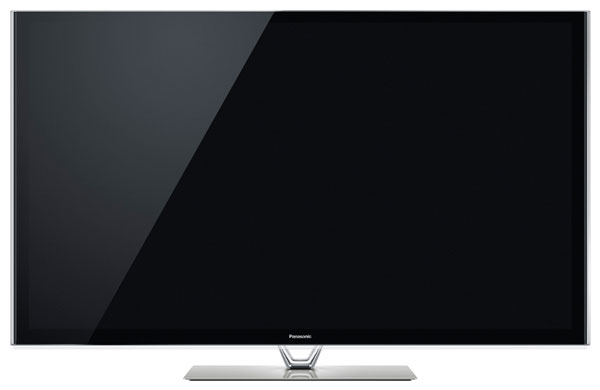
Designs are subjective, but we don’t think many people would disagree that the TXP55VT65 looks great. The entire panel has one sheet of glass covering it, which, coupled with the transparent acrylic border just below the frame, has the effect of making the picture “float”. The supplied table-top stand actually elevates the screen itself upwards by a decent amount, which further strengthens this effect.
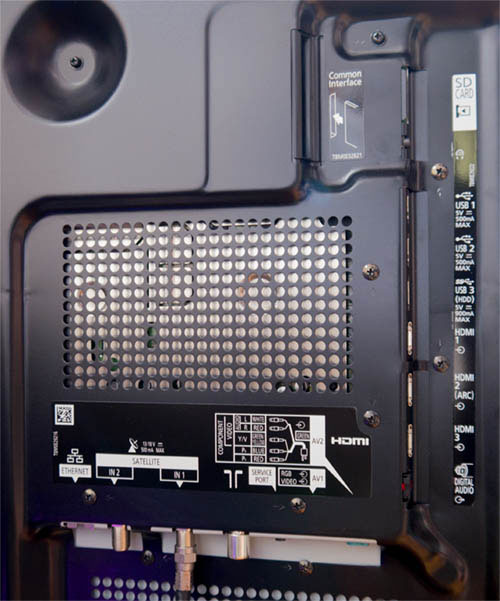 |
| Rear: 3 x HDMI, 3x USB, RGB Scart, Component, aerial, Freesat, ethernet & audio outs |
The TX-P55VT65B’s picture menus are basically identical to those found on the previously reviewed 50in GT60, so forgive us for indulging in some regurgitation here. Once you’ve unlocked the [Professional Mode (isfccc)] control in the Setup menu, you’ll be left with eight [Viewing Modes] to play with, though personally we’re only interested in the ones which preserve the accuracy of the source, namely “THX Cinema”, “Custom”, “Professional1” and “Professional2”.
![[Picture] menu](https://www.hdtvtest.co.uk/news/wp-content/uploads/2018/04/hdtv_Panasonic-TXP55VT65_picture1.jpg) |
| [Picture] menu |
There are some small (positive) differences we were not expecting, relative to our experiences with the TX-P50GT60B. On that plasma, the [Professional] modes would crush out rarely-used “Whiter than white” shades in the video signal, which in extreme circumstances could result in very bright highlight details losing a small amount of detail. The [Custom] mode retained these details. On the TX-P55VT65, all picture modes feature the whiter-than-white shades. Either the behaviour has always been different on the VT65, or Panasonic has changed it since we originally published the first review.
Similarly, on the 50GT60, the “THX Cinema” mode displayed with slightly more plasma-generated noise in the picture, indicating that it was output with lessened gradation. That is not the case on the TXP55VT65B we reviewed. In any case, it’s largely inconsequential given that the 55VT65 features several picture modes that will serve users who want to see accurate video without spending extra money on calibration (although as always we recommend that these users change their mind, since a Plasma panel of this quality deserves it).
Note: Our Panasonic TX-P55VT65B review sample was calibrated using CalMAN 5, the industry-leading video calibration software.
After letting our TX-P55VT65 review unit age for an appropriate number of hours, we profiled our Klein K-10 colorimeter against our resident i1Pro 2 to take advantage of the best accuracy attributes of both devices, and then measured grey window test patterns from the screen. We found that both the “THX Cinema” and “Professional” modes had similar greyscale mixing (a similar colour temperature), but that the “Professional” modes yielded more accurate gamma, so we went with that option.
First, a word on contrast performance, specifically light output. Last year’s European GT50 and VT50 plasma televisions featured constrained screen brightness when the [Professional] modes were used. Unfortunately, those were the only modes that provided in-depth calibration controls for extracting the very best picture quality from the panel. That limitation is gone this year, since Panasonic has added a [Panel Luminance Setting] control (previously not present on the Japanese manufacturer’s plasmas sold in the UK and Europe). We scoped out the different picture modes and [Panel Luminance Setting] controls to see which one resulted in the most suitably bright picture, without distorting the gamma tracking (the distribution of light output in the image).
In the “Min” luminance setting, the THX Cinema mode’s peak video white measured at 97 cd/m2, which is sufficiently bright. “Professional” was a little lower at 76 cd/m2, and raising the [Contrast] did not have a huge effect. However, setting the Panel Luminance Setting to “Mid” resulted in 114 cd/m2 output. The TX-P50GT60 we measured was a little brighter, but not to any appreciable extent. We imagine the very small difference is the result of the larger screen size vs power saving, and perhaps also the VT’s more effective anti-reflective coating (which may suppress some of the TV’s brightness in exchange for less screen reflections). In any case, we were able to get sufficiently bright pictures out of our 55″ VT65.
For an uncalibrated HDTV, the Viera TXP55VT65B’s pre-calibrated greyscale tracking in “THX Cinema” mode was fairly good, although plus-red greyscale mixing in mid-tones and brighter regions of the image added a little bit of unwanted warmth to colours:
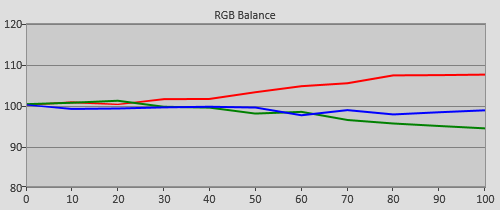 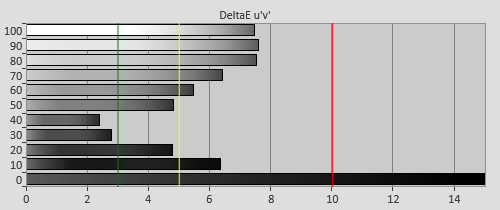 |
| Pre-calibration RGB tracking and delta errors (dEs) |
Calibration was a cinch on the Panasonic 55VT65. Using only the two-point White Balance controls, we achieved errors of less than 3 dE at all measured points from 20% brightness and up. The remaining small tint in the 10% (above black) area, we dealt with with the 10-point white balance adjustments, which would have allowed us to adjust the 20, 30, 40 etc. points had it been necessary. We’re delighted that the greyscale mixing was so consistent at each brightness step without having to reach for the more precise 10-point control, because on a plasma television, the greyscale mixing varies depending on the overall brightness of the scene being displayed. That means that applying large and very specific corrections with the 10-point control is best avoided, because the corrections that worked for the defined brightness levels in test patterns might create more of a visible problem in the less predictable realm of real-world footage.
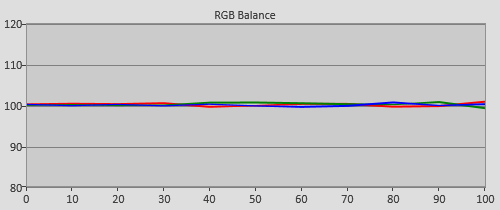 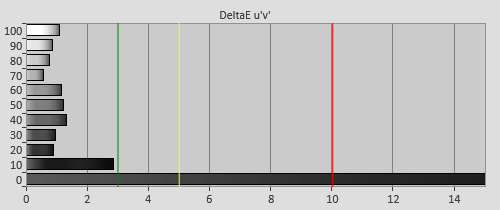 |
| Post-calibration RGB tracking and dEs in [Professional] mode |
As with basically every Panasonic plasma TV we’ve reviewed recently, the Viera TXP55VT65, when assessed using windowed grey test patterns, exaggerates shadow details. We used the 10-point Gamma correction to offset this, although as we always point out, a plasma’s gamma tracking is rarely consistent and in fact changes by a decent amount depending on the overall brightness of the scene being displayed (the APL, or average picture level). So, it’s all very well to make adjustments for the APL “in use” during the test patterns, but it’s essential to check a lot of real video footage afterwards to make sure no ill effects creep into real content, which uses a variety of different brightness levels.
![Pre-calibrated Gamma tracking in [THX Cinema] mode](https://www.hdtvtest.co.uk/news/wp-content/uploads/2018/04/hdtv_Panasonic-TXP55VT65_pre-gamma.png) | ![Post-calibrated Gamma tracking in [Professional] mode](https://www.hdtvtest.co.uk/news/wp-content/uploads/2018/04/hdtv_Panasonic-TXP55VT65_post-gamma.png) |
| Pre-calibration gamma tracking (2.2) | Post-calibration gamma tracking (2.4) |
Colour accuracy on the Panasonic TX-P55VT65B was absolutely sublime. In fact, we barely had to touch the Colour Management menu at all. After calibrating greyscale, with the “Rec.709” colour gamut preset (the default in the “Professional” modes), the VT65 already reached a visibly perfect level of accuracy (that means all dEs of less than 3, for the calibration techs).
Prior to greyscale calibration – that is, in the out-of-the-box “Professional” modes, the P55VT65’s very consistent (linear) saturation tracking was in evidence, with all colours being slightly red-tinged owed to the red-tinted greyscale we measured earlier. However, notice how the measurement dots on the chart are consistently offset by basically the same amount to the bottom right:
![Pre-calibration Colour saturation tracking in [THX Cinema] mode](https://www.hdtvtest.co.uk/news/wp-content/uploads/2018/04/hdtv_Panasonic-TXP55VT65_pre-strack.jpg) |
| Pre-calibration colour saturation tracking |
![Pre-calibration colour errors in [THX Cinema] mode](https://www.hdtvtest.co.uk/news/wp-content/uploads/2018/04/hdtv_Panasonic-TXP55VT65_pre-strack-de.png) |
| Pre-calibration colour errors (<3 not appreciable to the eye) |
…meaning that, after we calibrated the overall slight red tinge out with the [White Balance] controls, we were left with no visible colour errors at all. Since we had the options available, we actually did make a few more slight adjustments, purely for the sake of being complete:
![Post-calibration colour saturation tracking in [Professional] mode](https://www.hdtvtest.co.uk/news/wp-content/uploads/2018/04/hdtv_Panasonic-TXP55VT65_post-strack.jpg) |
| Post-calibration colour saturation tracking |
![Post-calibration colour errors in [Professional] mode](https://www.hdtvtest.co.uk/news/wp-content/uploads/2018/04/hdtv_Panasonic-TXP55VT65_post-strack-de.png) |
| Post-calibration colour errors (<3 not appreciable to the eye) |
Like so many 3DTVs we’ve reviewed, the Viera TX-P55VT65B does not appear to have been optimised to produce a completely naturally-coloured image after the 3-D glasses are taken into account. The fact that each pair of glasses has their own individual tint will have a lot to do with this, but we think Panasonic and THX (this is a measurement of the “THX3D Cinema” mode) should sample a wider variety of eyewear, and program some pre-compensation into the display to give a more naturally coloured extra-dimensional image for viewers who don’t have access to 3D calibration – which is surely 99.9% at least!
3D mode on the VT65 had a visible (to our calibration-grizzled eyes) but not devastating red tint:
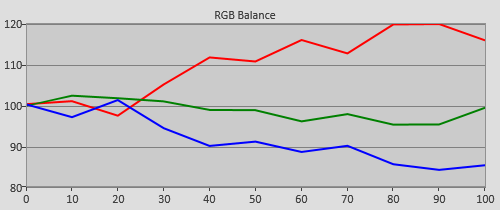 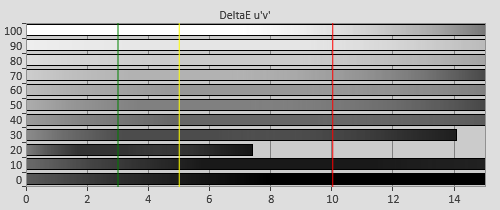 |
| 3D pre-calibration RGB tracking and delta errors (dEs) |
Since we have the means, we adjusted the tint out by colouring the pictures coming out of the 3DTV overly blue, meaning that when summed with the red tint of the glasses, it resulted in accurate, neutral grey shades reaching our eyes:
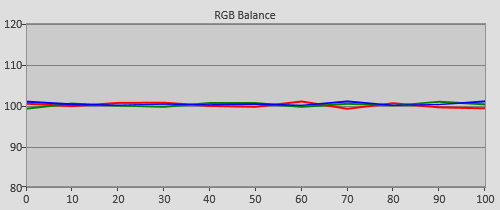 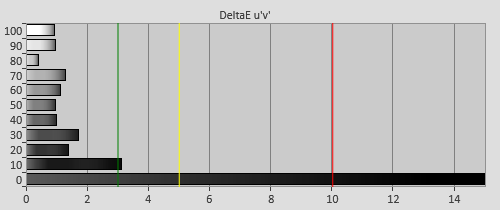 |
| 3D Post-calibration RGB tracking and dEs in [Professional] mode |
Prior to calibration, measured colour accuracy in the tri-dimensional mode was affected by the overly warm colour temperature:
![3D pre-calibration saturation tracking in [THX3D Cinema] mode](https://www.hdtvtest.co.uk/news/wp-content/uploads/2018/04/hdtv_Panasonic-TXP55VT65_3d-pre-strack.jpg) |
| 3D pre-calibration saturation tracking |
![3D pre-calibration colour errors in [THX3D Cinema] mode](https://www.hdtvtest.co.uk/news/wp-content/uploads/2018/04/hdtv_Panasonic-TXP55VT65_3d-pre-strack-de.png) |
| 3D pre-calibration colour errors (<3 not appreciable to the eye) |
After correcting Greyscale (which influences the picture’s colours), colour accuracy improved many times. As in 2D, we only had to make small adjustments with the colour management menu to achieve this great result:
![3D Post-calibration saturation tracking in [Professional] mode](https://www.hdtvtest.co.uk/news/wp-content/uploads/2018/04/hdtv_Panasonic-TXP55VT65_3d-post-strack.jpg) |
| 3D Post-calibration saturation tracking |
![Post-calibration colour errors in [Professional] mode](https://www.hdtvtest.co.uk/news/wp-content/uploads/2018/04/hdtv_Panasonic-TXP55VT65_3d-post-strack-de.png) |
| 3D Post-calibration colour errors (<3 not appreciable to the eye) |
| Dead pixels | None |
| Screen uniformity | Excellent |
| Overscanning on HDMI | Excellent – defeatable with 16:9 content |
| Blacker than black | Passed |
| Calibrated black level (black screen) | 0.003 cd/m2 |
| Calibrated black level (ANSI checkerboard) | 0.007 cd/m2 |
| Black level retention | Excellent – stable |
| Primary chromaticity | Excellent |
| Scaling | Excellent |
| Video mode deinterlacing | Excellent – Very effective jaggies reduction |
| Film mode deinterlacing | Excellent – Passed 2-2 PAL and 3-2 NTSC tests |
| Viewing angle | Excellent, but screen filter lessens vertical viewing angle |
| Motion resolution | Excellent (1080 lines) |
| Digital noise reduction | Excellent – optional |
| Sharpness | Very Good, full resolution, almost invisible undefeatable high frequency sharpening |
| Luma/Chroma bandwidth (2D Blu-ray) | Full Luma, chroma has slight vertical limitation (even in [1080p Pure Direct] mode) |
| Image retention | Very little |
| Posterization | Very small “hardened” edges during fast motion, moreso with very fast motion and high output rate (50hz content outputs at 100hz) |
| Phosphor trails | Very mild, can be reduced further with [Intelligent Frame Creation] on “Min” |
| 1080p/24 capability | Excellent – no judder in 2D or 3D |
| Input lag (high-speed camera) | 23ms compared to lag-free CRT |
| Leo Bodnar input lag tester | 41ms |
| Full 4:4:4 reproduction (PC) | No, chroma vertically softened |
| [THX Cinema] mode (2D) | 238 watts |
| [THX3D Cinema] mode (3D) | 424 watts |
| Calibrated [Professional] mode (2D) | 260 watts |
| Calibrated [Professional] mode (3D) | 355 watts |
| Standby | 1 watt |
Both Panasonic’s TX-P42ST60 and TX-P50GT60 plasmas managed an incredibly deep black of just 0.005 cd/m2 (measured using a freshly black-calibrated Klein K-10 colorimeter with many thousands of averaged readings). We were curious to see how the higher-up TX-P55VT65 would perform, since it is rated as having “Infinite Black Ultra” rather than the step-down models’ “Infinite Black Pro”. Another area of the spec sheet refers to the VT65/VT60’s filter separately, mentioning that it shares the “High Contrast Filter Pro” alongside the ZT65/ZT60, with “High Contrast Filter” (no “Pro”) being the reserve of the ST60 and GT60.
It’s not entirely clear exactly what the “Infinite Black” term relates to: Panasonic’s marketing group has used the term to refer to both the TV’s lowest possible (dark-room) black level, the effectiveness of the panel’s antireflective coating, and the two combined.
Fortunately, we have repeatable, accurate scientific measurements to cut through the marketing and verify exactly what’s what. After 100+ hours of aging, we measured the TX-P55VT65B’s black level at just 0.003 cd/m2, which is minutely better than our reigning black level champion, the last-gen Pioneer KURO plasma TVs (such as the PDP-LX5090). Just to be pernickety, the reading would occasionally register as 0.004 cd/m2, but 0.003 cd/m2 was the predominant measurement. We also performed several black level calibrations of the K-10 to add another layer of accuracy to the measurement. By the way, for completeness, we should state that after measuring peak white and jumping back to black, the reading would initially be around 0.005, before lowering to 0.003/0.004. We imagine this is related to phosphor afterglow. In any case, differences this tiny (0.001th of a nit!) are not visible to the eye.
However, we are splitting hairs (okay, splitting nits) – even if it had featured the same 0.005 cd/m2 blacks we measured from the lower-down models, we would still be entirely satisfied. Yet, the TXP55VT65 is better than we expected: its black-level performance is phenomenal, like all of Panasonic’s recent plasma HDTVs.
During the ANSI checkerboard test, which puts an equal number of black and white boxes on screen together, the Panasonic TXP55VT65B held onto its deep blacks, keeping them down at 0.007 cd/m2.
As for overall contrast performance – that is, taking into account blacks and peak whites – a standard-sized window pattern on the 55in VT65 hit our target of 120 cd/m2 easily. That is a huge improvement on the Panasonic VT50 series, which could produce very high video quality, but had their peak light output curtailed in their “Professional” modes (the ones which offered the most extensive calibration controls).
The 2013 Panasonic plasmas are comparatively compromise-free when it comes to the peak screen brightness. The TX-P55VT65B produces high picture gradation AND high light output simultaneously. However, our review unit needed a little bit of extra coaxing to achieve this brightness compared to the smaller 50-inch GT60 we tested. On that plasma, we could use the lowest Panel Luminance Setting to achieve this result; whereas on the 55VT65, we had to reach for the middle setting (“High” is not recommended because it compromises the accuracy and overall quality in exchange for brighter output). We imagine the result is largely to do with the difference in screen size, although there is also the possibility that the P55VT65B’s screen filter (which blocks more ambient reflections) does also decrease the luminous efficiency of the panel slightly.
Panasonic Plasma TVs haven’t had any huge difficulties with motion for a while now, and unsurprisingly, the same is true of the Viera TX-P55VT65. We still can’t tell the difference between the “3000hz” and lower-down “2500hz” and “2000hz” variants of the company’s Focused Field Drive; all three produce very crisp moving images.
Assessed with the FPD Benchmark test disc, the TXP55VT65B, unsurprisingly, returns all 1080 lines (okay, the thinnest lines on the darker portion of the test can become slightly less distinct). Enabling the “Min” [Intelligent Frame Creation] mode uses a very small amount of digital motion interpolation and results in slightly less plasma picture noise and also makes coloured phosphor trails less visible; although in return eagle-eyed viewers might see the occasional motion interpolation glitch (inevitable given the speed the motion calculations must be performed at). The “Min” setting, by the way, does not add the video-like “soap opera” motion to film content; it is a very light setting. Our favourite setup was to leave the interplation features off entirely for 24p film from Blu-ray (the 24fps frame rate is too low to reveal motion issues) but to set it to “Min” for 50hz video material, such as UK/European broadcast TV. “Min” with TV content reduced the appearance of double-imaging effects, and also produced smoother gradations during fast movements (for example, the “oily skin” effect sometimes seen on plasma televisions). We don’t recommend the “Max” setting, though, since it forces the TV to output 50hz content as 60hz, which can lead to motion juddering.
We were wondering if the VT65 would be the first Panasonic plasma-based 3DTV in a while to produce full-resolution 3D output at each brightness emission step from the screen… the company’s plasma televisions use a novel technique to improve other aspects of three-dimensional picture quality (such as gradation and contrast – the latter especially being a sore spot for many home 3D TVs); the side-effect being some occasional jaggies in the picture. Like the rest of the range, the Panasonic TX-P55VT65B also uses the Multiline Simultaneous Scanning Method, which effectively means that the highest contrast (most visible) changes in the picture are drawn at full resolution, but intermediate brightness steps are drawn at the equivalent of 540p. It’s an interesting technique which has clearly been deployed for good reason.
So, what does it all mean for 3D picture quality? As usual, the P55VT65 produces a very satisfying extra-dimensional experience, and one that’s surprisingly bright, too. Crosstalk is still sometimes visible, and the out-of-the-box 3D image still has a red tint (although few will ever notice this because very few people will ever have seen a calibrated 3D TV), but the predominant characteristic of the TXP55VT65B’s 3-D images are their excellent sense of depth.
Also, like all of the company’s 3D Viera plasmas, the 55-inch VT65 outputs all tri-dimensional content without judder or stutter, owed to the fact that these signals are always output at a panel refresh rate which is an exact multiple of the input signal rate. Unlike many LED LCD 3DTVs, there is no motion judder – or motion interpolation designed as a band-aid to conceal judder – on the 55VT65, just natively smooth motion quality.
The SD processing on the TX-P55VT65 is every bit as good as the GT60’s, with crisp and clean upscaling of lower-resolution signals to fill the 1920x1080p panel. Like most manufacturers, Panasonic has suppression of jaggies during the upscaling process down to a fine art, and the TX-P55VT65B also correctly processes film-to-SD transferred content properly, passing the relevant 2-2 PAL film mode deinterlacing checks.

It shouldn’t surprise any readers to hear that the Panasonic VT65 features absolutely outstanding picture quality. Given how delighted we were with the cheaper models, we would be surprised if we had to report anything different here, although it’s not totally out of the realm of possibility (see 2012’s Panasonic plasma TV lineup, where the midrange ST50 model delivered a brighter picture than the higher-end units).
It’s difficult to write an analysis of a screen of this quality, because as critics, there is nearly nothing for us to criticise. Ultimately, we are only going to be describing what brilliant video looks like… so here goes! When driven by top-quality Blu-ray Disc content, the Panasonic TXP55VT65B’s pictures are simply sublime. It produces full luma resolution (we really hope people stop mentioning the idea that “plasmas are less sharp than LED LCDs” – it is bogus and all it takes is a test pattern to verify that the screen is fully reproducing tiny picture details) and also does not partake in any annoying noise/film grain reduction, unless the viewer enables it, meaning that the richness and full quality of movie content comes through without any smearing or dampened motion details. The contrast performance on both ends of the scale is outstanding, with the deepest blacks we’ve seen on a flat-screen HDTV (barring OLED and ZT60 prototypes at trade shows) with simultaneous display of bright whites (okay, they’re not LCD bright, but we’d much rather have a television like this with outstanding blacks and great white output, than an LCD with eye-searingly bright whites and mediocre black-greys: black-level performance is tremendously important to picture quality).
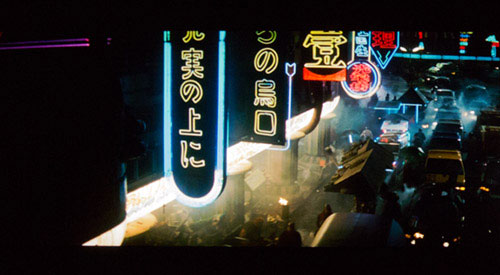
We ran our TX-P55VT65B review sample side-by-side with the TX-P50GT60, and fed both TVs with the same Blu-ray Disc player, piping the same signal to both screens. We checked out both TV sets in their out-of-the-box modes, and also calibrated, to assess them on a level playing field. In dark-room viewing, there is effectively no picture quality difference between the two after calibration – even the difference in black level is incredibly minute with most content, although it could be noticed in a dark viewing environment with dark content (think night-time space scenes, and so on). One difference was that if we stood up and looked at bright details in a dark scene (white text on a black background being a mundane example), the VT65 would show a very small amount of glow around the letters; this is internal reflections resulting from the “one sheet of glass” design (the GT60 features only a bare panel, whereas the flagship ZT65 will feature a new panel manufacturing process which eliminates the double images). This didn’t bother us in the slightest, though, and we mention it only for completeness.
One minor difference between the Panasonic VT65 and GT60 relates to gradation – that is, the number of unique tones the plasma panel can show before it has to resort to dithering. Panasonic quotes the VT as having a higher number of gradations than the GT (30,720 vs 24,576), but in truth we could see essentially no difference even during gruelling tests. However, on the GT60 (and last year’s VT50 and GT50) the THX-branded picture modes did not output with the higher level of panel gradation. On the TXP55VT65B, they do.
One other difference we did spot as avid videophile users related to a form of “coloured line bleed” seen on Panasonic (and probably also other TV brands’) plasma displays, which can creep into black and white content. Imagine a black and white (or sepia-tinted) film scene with an actor in the foreground, with a dark background at the top of the frame, and a bright background (a bright window, for example) behind the actor in the middle. With “coloured line bleed”, the actor’s face would pick up a bit of false colour and have a very slightly different tint (we are talking single-digit percentages) in the area in front of the dark portion compared to the light portion. Well, our TX-P55VT65 review unit had almost none of this, whereas it was slightly more visible on the 50GT60 (and our older 50ST50).We saw this with the black-and-white Japanese film Harakiri during our testing. Just to be clear, it didn’t really bother us on either set, but the fact that our P55VT65B was basically free of it is still good to know. Whether or not that’s down to the different range, size, or even unit-to-unit variation, we’re not sure.
During daytime viewing, the VT65’s superior anti-reflective screen coating is visible in a side-by-side comparison, but it is not a night-and-day difference (pardon the phrasing). We still recommend LCD televisions for very bright, sunny rooms, but Plasma is absolutely king in the average home environment which is not flooded with light.
A final note for the most demanding videophile users, relating to the tiny (and effectively invisible) amount of sharpening Panasonic applies to the tiniest details in the picture. This was present on the GT60, and we did wonder if Panasonic would reserve total control over this for step-up models just to force pernickety video enthusiasts (us!) to shell out for the more expensive product, but apparently not, because the same behaviour is here on the TX-P55VT65B. The TV applies a very, very subtle boost to tiny details in the image. We’re not sure what the point is, because the plasma panel has no resolution limitation (in 2D) anyway, but it doesn’t damage the quality. One thing to double-check, though, is the [HDMI Content Type] menu: be sure all inputs are flagged as “Off”! There is a “Graphics” mode which applies huge sharpening to images, causing them to look lower-resolution as a result.
When we got our hands on one of the first 2013 Panasonic plasmas to hit shelves – that was the ST60 series – we were disappointed to find that the Japanese firm’s typical fast gaming responsiveness, while still adequate, was no longer in the territory of being truly special. Fortunately, the Viera GT60 series – the lowest-down model which uses Panasonic’s own video processor chip rather than one supplied by a third party – was a return to form.
Not surprisingly, the 55″ VT65 produces the same outstanding gaming responsiveness. We clocked input lag on the TXP55VT65B as being just 23ms using our traditional lag measurement process, which uses a fast CRT as the reference. The dedicated Leo Bodnar input lag testing device clocked the plasma in at a 41.5ms, using the [Professional] picture mode with [Game Mode] engaged. The result is buttery-smooth gaming responsiveness that truly immerses the player in the game world without any lag to get in the way of the constant feedback loop required during gameplay.
Unlike previous Panasonic plasma TVs, the “Game Mode” is not a separate picture mode but is a setting which can be enabled in any picture mode. That means that video gamers now have access to the same level of high accuracy that was previously reserved only for slower modes.
The Panasonic TX-P55VT65B is an utterly outstanding plasma television, which we have essentially no qualms about awarding a “Reference Level” rating to. The fact that this level of picture quality can be made this affordable, rather than being reserved only for the highest-end, is a true triumph of engineering. Basically every single box is ticked by the VT65 series: insanely deep blacks that are almost (almost!) too dark to measure with scientific-grade equipment, bright whites, high gradation, freedom from viewing angle restrictions, low input lag for gaming, and of course, a boatload of usability features like the slick, responsive Smart TV platform and dual tuners. Oh, and did we mention the potentially sublime level of colour accuracy?
The Viera VT65 is likely to be seen as a worthy upgrade over the GT60 by users who are looking for a premium plasma TV. The picture quality is not leaps and bounds over the cheaper model (such is the nature of high-end AV), and that’s no disappointment, because the GT60 is also an utterly brilliant HDTV which satisfied our requirements for a “Reference Level” rating. However, our TX-P55VT65 review sample produced black level quality that’s better still (while still satisfying us with bright whites), and features a slightly better anti-reflective screen filter. On top of that, there is also the sleeker design, integrated webcam, and dual tuner functionality.
We think it’s fair to say that if you like the outstanding picture quality of plasmas, and don’t have any aversion to this display technology, then you will love the TXP55VT65B as much as we did. We can’t recommend it highly enough – it’s a product that there is nearly nothing wrong with. If the reports are true that Panasonic are stopping PDP R&D but will continue to release new models using the existing technology, then we wouldn’t be too surprised, because given the quality of the VT series, we wonder if it can even get much better. We’ll see when we review the top-end, elusive ZT model later. What a year for Plasma 2013 is turning out to be!
